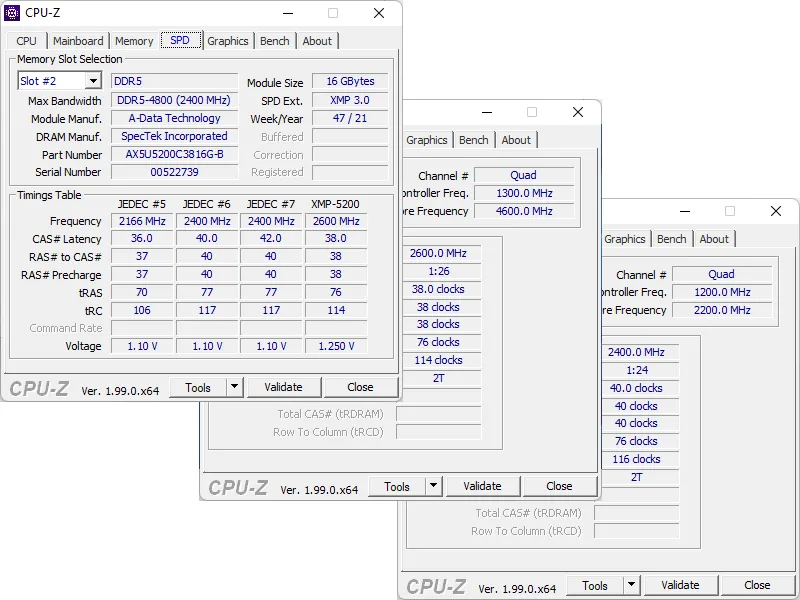Adata XPG Lancer RGB DDR5-5200 Review: Value-Priced Performance
Adata’s XPG Lancer DDR5-5200 is among the options available to buyers who seek RGB without the high price of Corsair’s previously-reviewed Dominator Platinum 5600 kit. At $312, it’s much closer to the price of Crucial’s plain DDR5-4800. Its price is so much closer to that of the bare module kit that it’s almost as if those willing to pay for a bit more bandwidth are getting the RGB for free.

Get it at Amazon

(click for availability)
Available as part number AX5U5200C3816G-CLARBK, the twin pack of 16GB modules (32GB total) comes programmed with CAS 38 XMP-5200 timings, splitting the difference between the cheaper kit’s C40 and the pricier kit’s C36. Detected at DDR4-4800 C40, enabling a motherboard’s XMP is all that’s needed to get the XPG Lancer DDR5-5200’s rated settings.

Adata no longer lists its beta RGB software on new product pages, but its XPG RGB is compatible with Asus Aura Sync, Gigabyte RGB Fusion 2.0, MSI Mystic Light Sync, and ASRock Polychrome Sync. So, if you have a motherboard to put these in, you probably already have the RGB software needed to change modes from the rainbow default to something more suitable to your component color scheme.

Test Hardware Configuration
| CPU | Intel Core i9-12900KF: 16C/24T, 3.2-5.2 GHz, 30 MB L3 Cache, LGA 1700 |
| CPU Cooler | Alphacool Eisblock XPX CPU, VPP655 with Eisbecher D5 150mm, NexXxoS UT60 X-Flow |
| Motherboards | DDR5: ASRock Z690 Taichi, BIOS 1.43 DDR4: ASRock Z690 Extreme WiFi 6E, BIOS 2.02 |
| Comparison RAM | Corsair CMT32GX5M2X5600C36 2x 16GB (32GB) DDR5-5600 36-36-36-76 1.25V Crucial CT2K16G48C40U5 2x 16GB (32GB) DDR5-4800 40-39-39-77 1.10V Mushkin MLA4C400JNNM16GX2 2x16GB (32GB) DDR4-4000 18-22-22-42 1.35V |
| Graphics | Gigabyte GeForce RTX 2070 Gaming OC 8G: 1410-1725 MHz GPU, GDDR6 |
| Power | be quiet! Dark Power Pro 10 850W: ATX12V v2.3, EPS12V, 80 PLUS Platinum |
| Hard Drive | TOSHIBA OCZ RD400 256GB NVMe 1.1b SSD |
| Sound | Integrated HD Audio |
| Network | Integrated Wi-Fi |
| Graphics Driver | GeForce 496.49 |
We’re comparing XPG Lancer DDR5-5200 to the three best-performing kits of previous reviews, including Corsair’s DDR5-5600, Crucial’s DDR5-4800, and Mushkin’s DDR4-4000. The later kit has some advantages in latency, but we’ve already seen that DDR5 outperforms it overall.
Overclocking & Latency Reduction

The cat’s out of the bag as soon as we try to overclock: XPG Lancer DDR5-5200 uses the same D8BNJ DRAM ICs as Crucial’s DDR5-4800. The overclocking experience was different this time though, as nearly every change we made in voltage or timings made the overclock settings less stable. It reached the same clock as Crucial’s kit while using its as-delivered 1.25V VDD and VDDQ settings, and increasing either or both to 1.35V appeared to do nothing at best.

It also supported the same CAS 36 timings at DDR5-4800 as the Crucial kit. XPG Lancer DDR5-5200 needed at least CAS 37 to reach its rated DDR5-5200, which is only one cycle quicker than its rated CAS 38.
| Lowest Stable Timings | |||
| DDR5-6400 | DDR5-5600 | DDR5-4800 | |
| Adata XPG Lancer DDR5-5200 C38 AX5U5200C3816G |
X | X | 36-36-36-72 (2T) |
| Dominator Platinum RGB DDR5-5600 C36 CMT32GX5M2X5600C36 |
X | 34-34-34-68 (2T) | 28-28-28-56 (2T) |
| DDR5-4800 CAS 40: Crucial by Micron CT2K16G48C40U5 |
X | X | 36-36-36-72 (2T) |
| DDR4-4000 CAS 18: Mushk. Redline Lumina MLA4C400JNNM16GX2 |
X | X | X |
Benchmark Results
As expected, XPG Lancer DDR5-5200 splits the difference in both bandwidth (more is better) and latency (less is better) between Dominator Platinum DDR5-5600 and Crucial DDR4-4800.






Unlike other DDR5 kits, XPG Lancer DDR5-5200 performed better in 3DMark when using XMP settings rather than overlocked or reduced-latency manual settings. That should be fine with most buyers, since most will do nothing more than enable XMP.

Previous tests have shown that F1 2021’s “memory bottleneck” goes away around DDR4-3600 on our test system, which probably means that our graphics card has become the restricting factor. While this diminishes its benchmark value, we doubt anyone is really running 1080p at medium details just to get over 200 FPS.

File compression shows the biggest difference between DDR5 and DDR4, but the differences between different DDR5 data rates are less impressive. When considering every kit’s XMP values, XPG Lancer DDR5-5200 nearly matches Dominator Platinum DDR5-5600 in our real-world test.


We started off by noticing that the XPG Lancer DDR5-5200 kit was far closer in price to a basic DDR5-4800 kit than to an RGB DDR5-5600 kit, and further examination showed that it’s no more tunable than the cheaper kit. But most people don’t manually configure their memory, and the XPG Lancer’s factory XMP tune is nearly perfect for its price, even before considering how much value its RGB lighting adds. If you’re in the market for both performance and pizzazz, it’s a killer value.
| Pros: | Cons: |
|
|
| The Verdict: | |
| Closer in price to a bare DDR5-4800 kit than a fully-dressed DDR5-5600 kit, Adata’s value-priced XPG Lancer DDR5-5200 offers all the pizzaz of the later while spitting the performance difference against both. | |

